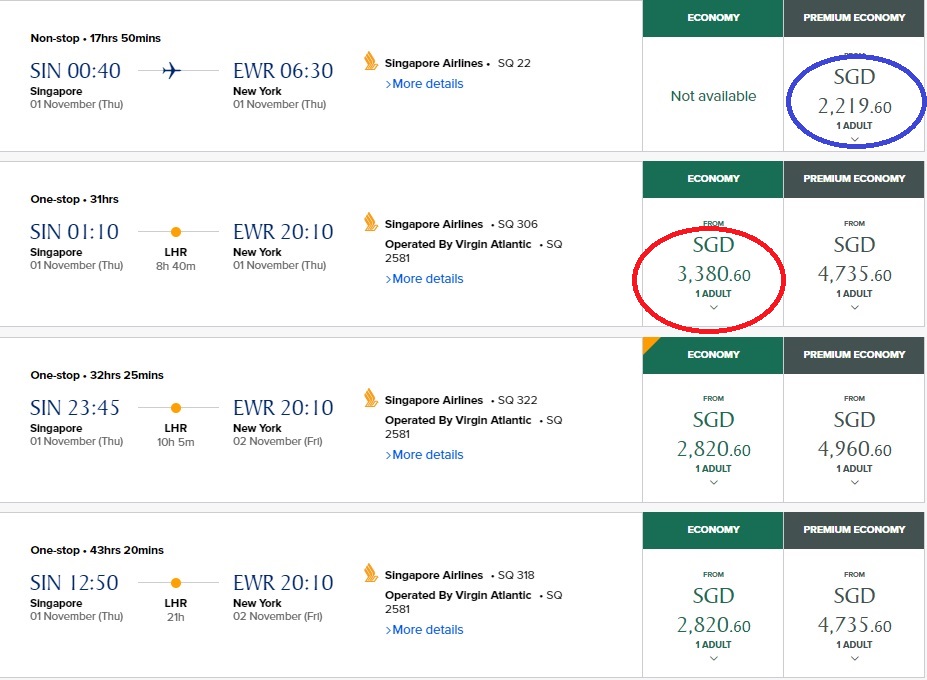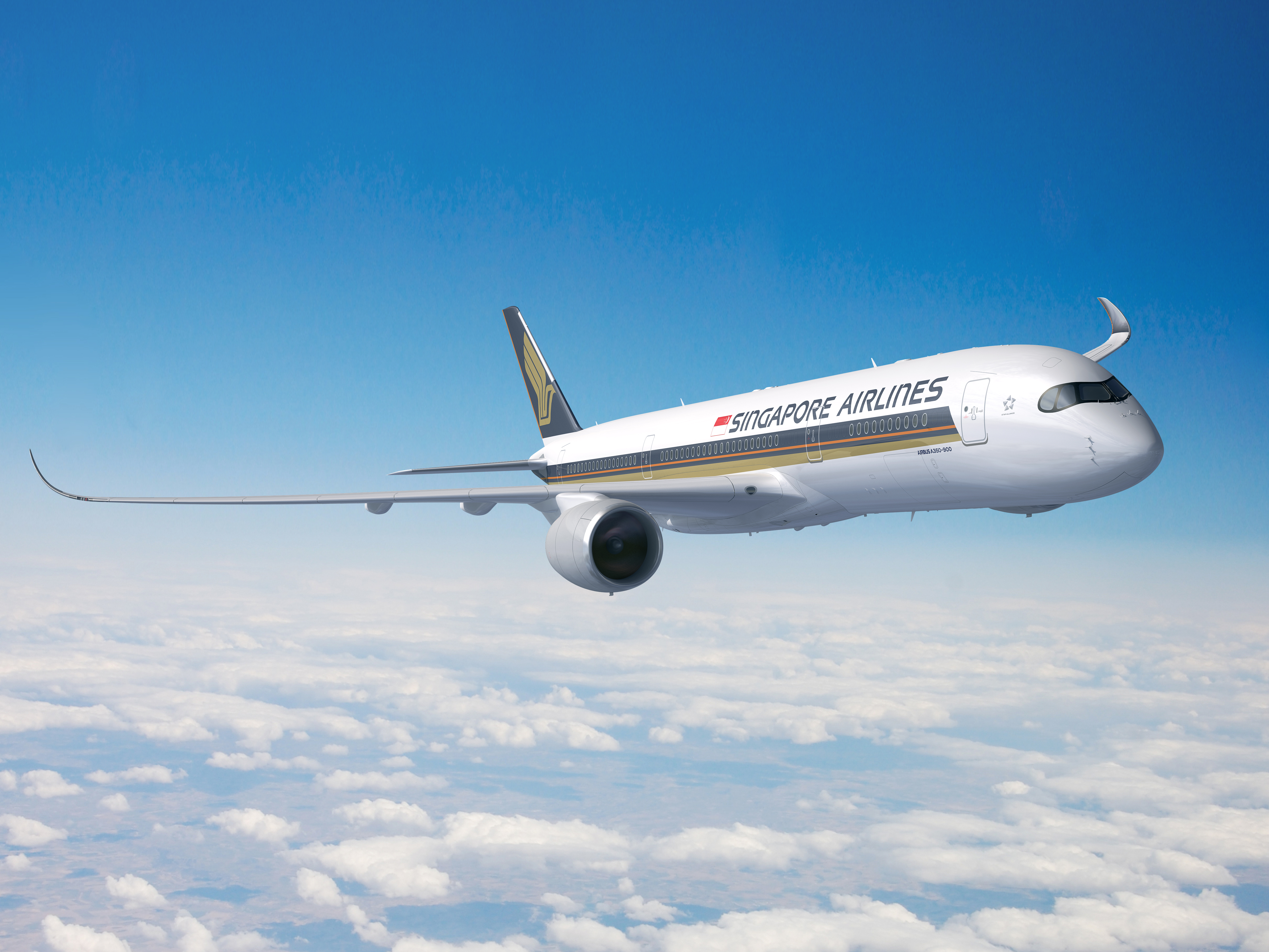It is here.
Singapore Airlines has officially announced it will resume its non-stop Singapore to New York flights — the world's longest — from Oct 11, 2018.
It will be operated by an Airbus A350-900 ULR (ultra-long-range), and will fly to Newark Airport. The route will initially be operated three times a week, though daily flights will commence from Oct 18 once an additional A350-900 ULR jet enters service.
Not-so-bad prices
A round-trip in Premium Economy starts from S$2,219, while a round-trip in Business Class starts from S$4,919.
While the prices may seem high, it is important to note that they are, in fact, significantly cheaper than SIA's own one-stop options:
 Image via Singapore Airlines
Image via Singapore Airlines
Both Premium Economy and Business Class can be found at less than half the price of the one-stop flights.
In fact, the Premium Economy price on this flight is even cheaper than the cost of an Economy Class ticket on the one-stop routes, which is pretty crazy:
 Image via Singapore Airlines
Image via Singapore Airlines
[related_story]
Unique cabin configuration
The non-stop flight's plane cabin will be set up in a two-cabin configuration, with 67 Business Class seats and 94 Premium Economy seats, with a total of 161 seats.
In comparison, SIA's regular A350-900 consists of 253 seats.
This means that the aircraft for this flight is specifically designed to carry fewer passengers.
However, none of the other world's longest flights are operated with such a premium-heavy configuration. All of them retain an Economy cabin, though the number of seats vary between different airlines.
The only other major airline with an all-premium configuration is British Airways, which operates an all-Business-Class flight between London and New York.
SIA likely expects a higher proportion of business travellers on this flight, in order to justify the configuration.
What's different?
This configuration is very similar to the previous iteration of this same flight, which was previously discontinued back in November 2013. It consisted of 67 Business Class seats and 117 Premium Economy seats (known as Executive Economy then).
With even fewer seats than before, SIA must expect healthy take-up for this flight in order to make a profit.
Fortunately, the circumstances now are more favourable.
While the Airbus A340-500 that was used to operate the previous route was a notorious fuel-guzzler, the A350-900 ULR is the opposite.
Made up of composite materials to ensure lighter weight, and modified winglets for aerodynamic improvements, the A350-900 ULR is far more fuel-efficient than its predecessor.
The design of the aircraft not only improves fuel performance, but also has a positive impact of passenger comfort.
Larger windows and higher ceilings, along with custom lighting that preps passengers for time changes will ensure that the 18-hour-and-45-minute journey will be as comfortable as possible. The carbon composite airframe also improves cabin altitude and humidity.
Race to the top
The race to the coveted title of longest flight in the world is an intense one.
On March 2, 2016, Emirates announced a non-stop flight from Dubai to Auckland, covering a distance of 14,201km. It was the world's longest flight then.
Less than a year later, Middle Eastern rival Qatar Airways quickly announced a non-stop flight from Doha to Auckland, covering a distance of 14,535km, edging out the Emirates flight by 334km.
On March 24, 2018, Qantas announced a non-stop flight from Perth to London, covering a distance of 14,500km, although it was not enough to dethrone Qatar Airways (the flight was a mere 35km short).
But the new non-stop route by SIA will cover a distance of 15,344km, a comfortable 809km ahead of the next longest route.
This is not the first time SIA has held the title of the world's longest non-stop flight.
Between 2004 and 2013, it held the title on the same route, though it was forced to suspend it due to high fuel prices that made the route highly unsustainable.
Significance of the route
Airlines do not introduce new routes just for bragging rights, naturally. The new route is very important to SIA for competitive reasons.
Currently, Singapore faces a disadvantage for its routes heading to the US.
While most airlines can command a premium for non-stop routes due to convenience, SIA has been unable to provide a direct route to the US, except its recently-added 16-hour non-stop flight to San Francisco.
It currently serves New York (JFK airport) via Frankfurt, Houston via Manchester, Los Angeles via Seoul and Tokyo, and San Francisco via Hong Kong, in addition to the non-stop flight.
Thus, SIA has no competitive advantage over other Asian airlines such as Cathay Pacific, Eva Airways and Japan Airlines, all of which can provide the same one-stop route to the US from Singapore.
This new non-stop route, should it prove successful, will be significant for SIA's long term growth.
The airline has already planned another non-stop route to Los Angeles, and with more A350-900 ULR aircraft on the way, one can only imagine that other US destinations may soon be on the cards.
Other airlines will also be observing SIA keenly from afar, and may base their own routing decisions on SIA's performance.
If the long-haul route proves successful, Qantas will likely be interested in acquiring the A350-900 ULR for a Sydney to London non-stop flight.
Currently, there are no non-stop flights between Sydney and London, with passengers typically connecting in either Singapore or Dubai.
Another implication is that the success of this route opens up the world for SIA, and Singapore in general.
The A350-900 ULR has a maximum range of approximately 17,964km.
This effectively means that every major city in the world can be connected to Singapore via a non-stop flight.
Nice.
Top image via Singapore Airlines
If you like what you read, follow us on Facebook, Instagram, Twitter and Telegram to get the latest updates.
